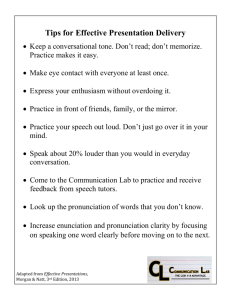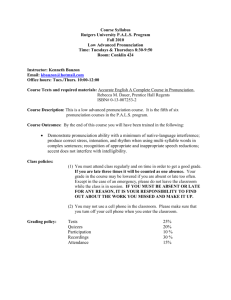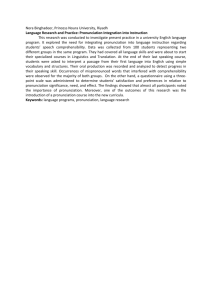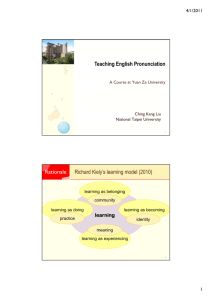Beyond "listen and repeat" - an overview of English pronunciation
advertisement
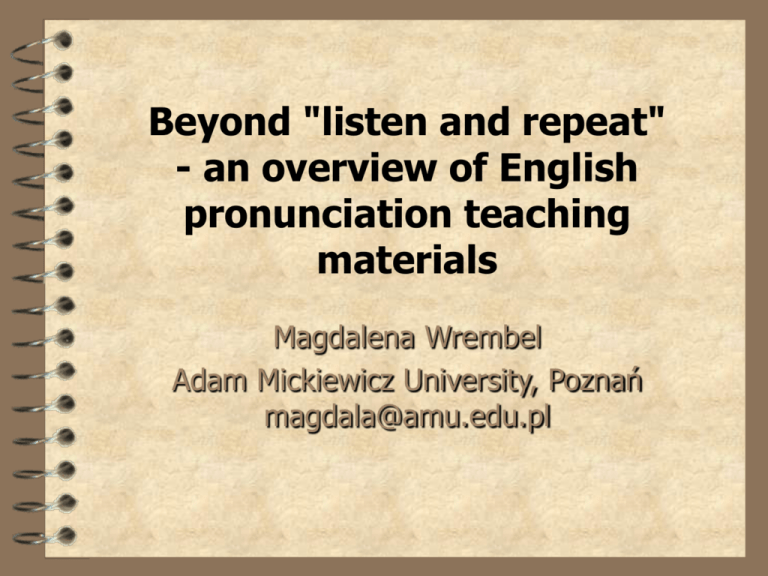
Beyond "listen and repeat" - an overview of English pronunciation teaching materials Magdalena Wrembel Adam Mickiewicz University, Poznań magdala@amu.edu.pl Introduction Unexplored question - have material designers responded to changing perspectives? Jones (1997): "In spite of a changed phonological focus [...] teaching techniques and tasks continue to rely on the behaviourist notions of SLA such as habit formation". My intention: to examine how recent SLA findings and new trends in pronunciation pedagogy are reflected in pronunciation materials Selected materials: – textbooks – computer software – Internet web sites 2 Outline of the presentation Theoretical introduction - changing perspectives in pronunciation pedagogy Analysis of materials – Model accents – Goals and priorities – Common core features – Pronunciation teaching techniques Conclusions 3 Changing perspectives in pronunciation pedagogy Historical outline of pronunciation instruction: Grammar Translation - irrelevant Direct Method - intuition & imitation Audiolingual Method - important, drills Communicative Approach - initially disregarded, growing awareness 4 Changing perspectives in pronunciation pedagogy (2) Shift in priorities (segmentals < suprasegmentals) Contextualisation and fluency-building Widened scope of pronunciation instruction Holistic approach Autonomy and speech awareness New technologies 5 Materials analysis - model accents Textbooks (31) CD-ROMs (13) Internet resources Phonetics reference BE-19 AE-10 ? - 2 BE- 4 AE-10 ? - 2 20 18 16 14 12 10 8 6 4 2 0 19 sites Phonetic labs Professional organisations Text files Sound files BE - books 10 AE - books 10 Other - books BE - CDs 4 2 BE AE - Other - BE books books books CDs AE - CDs 2 Other - CDs AE - Other CDs CDs 6 Target model variety - years of publication 25 20 15 BE AE 10 Other 5 0 1950 1960 1970 1980 1990 7 Redirection of priorities segmentals 20% 45% segmentals suprasegm. segm.+suprasegm. 35% 8 Focus on segmentals1 1960s-70s Detailed treatment of Vs & Cs Optional features: – consonantal clusters, – weak forms, – linking, – elements of stress & intonation 9 Focus on segmentals2 Textbooks: Baker,A. 1977. Ship or sheep? An intermediate pronunciation course. Baker, A. 1982. Tree or Three? An elementary pronunciation course. Barnard,G.L. & P.S.McKay. 1963. Practice in spoken English. Hooke,R. & J. Rowell. 1982. A handbook of English pronunciation. Kenyon,J. S. 1956. American pronunciation. MacCarthy,P.1965. A practice book of English speech. Munro Mackenzie,M.D.1973. Modern English pronunciation practice. 10 Segmentals + suprasegmentals1 1980s - 1990s Vs - quantitative & qualitative, emphasis differs Cs - focal areas: • aspiration, contrast, fortis / lenis, clusters Suprasegmentals: • stress & rhythm, connected speech, weak forms, intonation Additional features: • spelling - sound correspondence, guidance for different L1, voice quality 11 Segmentals + suprasegmentals2 Arabski,J. 1987. Wymowa amerykańska. Cunningham S, & B. Bowler. 1999. New Headway Pronunciation Course Hewings,M. 1993. Pronunciation tasks. A course for pre-intermediate learners. O'Connor,J. D. & J. Fletcher.1989. Sounds English. O'Connor,J. D. 1967 (1989). Better English pronunciation. Orion,G. 1997. Pronouncing American English: sounds, stress, and intonation. Ponsby, M. 1982. How Now, Brown Cow? Reszkiewicz,A. 1981. Correct your English pronunciation. Sobkowiak,W. 1996. English phonetics for Poles. CD PRONUNCIATION POWER CD SPEAK FLUENT AMERICAN ENGLISH CD MOULTON INTERACTIVE INTRO TO PHON & PHON CD FONETYKA ANGIELSKA W PIGUŁCE CD HUMMINGBIRD SOUND MACHINES 12 Suprasegmentals Stress - 1 (word stress, nuclear stress, unaccented syllables, schwa, weak forms) Rhythm - (thought groups) Intonation - (communicative function, discourse-based) Secondary importance – Connected speech – Individual sounds - selected aspects » aspiration, voicing, consonantal contrasts, clusters » vowel duration » practised in the context of connected speech 13 Suprasegmentals 2 Bogle,D. 1996. Practical phonology. Bradford, B. 1988. Intonation in Context. Brazil,D. 1994. Pronunciation for advanced learners of English. Gilbert,J. 1993. Clear speech. Miller,S.F. 2000. Targeting pronunciation: the intonation, sounds, and rhythm of American English. Morley, J. 1979. Improving Spoken English. Mortimer,C. 1985. Elements of pronunciation. Prator,C. 1951 (1985). A manual of American English pronunciation. Rogerson,P. & J.B.Gilbert. 1990. Speaking clearly. Vaughan-Rees, M. 1994. Rhymes and Rhythm. Weinstein, N. 1982. Whaddaya Say? Zawadzki, H. 1994 In tempo. CD BETTER ACCENT TUTOR.FOR AMERICAN ENGLISH CD PRONUNCIATION IN AMERICAN ENGLISH CD CONNECTED SPEECH 14 15 Pronunciation syllabi - common core features vs. LFC 85% weak vowel 77% intonation 74% word stress 70% vowel quantity 67% vowel quality 67% tonic stress 67% unstressed syllables 63% rhythm (thought groups) 59% diphthongs 56% dental fricatives 52% weak forms 52% consonants 48% elisions 46% 44% 41% 37% 37% 32% 18% 18% - consonantal clusters linking rhotic r assimilation aspiration fortis / lenis spelling / sound dark l 16 Pronunciation teaching techniques "Listen and repeat" Minimal pair drills – Sample materials: Higgin's Home Page, Baker 1977, Baker 1982, Barnard & McKay 1963, O'Connor 1967, O'Connor & Fletcher 1989, Orion 1997, Cunningham & Bowler 1999 Ear training -recognition/discrimination – Baker 1977, Baker 1982, O'Connor 1967, O'Connor & Fletcher 1989, Clear Speech Works (CD), Ponsby 1982, UCL Phonetic training – Reszkiewicz 1981, Arabski 1987, Brazil 1994, Orion 1997, The Mouton Interactive Introduction to Phonetics and Phonology (CD), Fonetyka angielska w pigułce (CD), PHON2, UCLA's Phonetic Lab, Maidment's Pronunciation Tip of the Day 17 Pronunciation teaching techniques (2) Reading aloud / recitation – Mortimer 1985, Bradford 1988, Brazil 1994, Ponsby 1982 Tongue twisters and poems – Vaughan-Rees 1994, Reck's Collection of Tongue Twisters Pronunciation games – Maidments' Sound Machines, Windmayer's Sounds of English Pronunciation Power (CD), Bogle 1996, Hancock 2003 Communicative / contextualised activities – Morley 1979, Bradford 1988, O'Connor & Fletcher 1989, Gilbert 1993, Hewings & Goldstein 1993, Brazil 1994, Miller 18 2000 Pronunciation teaching techniques (3) Pair work – O'Connor & Fletcher 1989, Miller 2000, Hewings & Goldstein 1993 Multisensory modes of presentation – Kinaesthetic reinforcement • Bogle 1996, Miller 2000 – Visual support • Sobkowiak 1996, Orion 1997, Pronunciation Power (CD), Clear Speech Works (CD), CSLU Toolkit Baldi Guidance for users of different languages: Cunningham & Bowler 1999, O'Connor & Fletcher 1989, Hancock 2003 19 Pronunciation teaching techniques (4) Transcription exercises – Bogle 1996, Orion 1997, Lecumberri & Maidment 2000 Integrated skills – Speak Fluent American English (CD), Gilbert 1993 Voice quality – Speak Fluent American English (CD) Sensitisation – Bradford 1988, Brazil 1994, Hancock 2003 Self-monitoring and learners' autonomy: – Brazil 1994, Miller 2000, CD-ROMs 20 Conclusions Greater variety in NS-model accents Redefined goals and priorities – intelligibility & communication Pronunciation syllabi - little compatibility with LFC Wider inventory of teaching techniques – beyond "listen & repeat" – consciousness-raising and self-monitoring 21 Internet resources Phonetics Reference Sites CyberPhon (acoustic phonetics) http://www.cyberphon.univ-lyon2.fr PHON2: Phonetics beyond the basics http://www.linguistics.reading.ac.uk/phon2 Pronunciation Web Resources - links http://www.sunburstmedia.com/PronWeb.html An overview of pronunciation software, D. Healey http://oregonstate.edu/~healeyd/tesol2002/pron.html 22 Internet resources (2) - text files John Higgin's Home Page - minimal pairs http://www.marlodge.supanet.com/ Michael Reck's Collection of Tongue Twisters http://www.uebersetzung.at/twister/en.html Sharon Windmayer's Sounds of English http://www.soundsofenglish.org Maidment's Pronunciation Tip of the Day http://www.phon.ucl.ac.uk/home/johnm/eptotd/tipho me.html SIL's IPA Fonts http://www.itl.atr.co.jp/comp.speech/Section1/Fonts/ 23 sil.ipa.html Internet resources (3) - practical activities on the Web John Maidments' Sound Machines http://www.eptotd.btinternet.co.uk/vm/soundmachin es.htm • Vowel Machine • Transcriber • TONI • PLATO Web-based transcription tool http://www.wtt.org.uk Sharon Windmayer's Sounds of English http://www.soundsofenglish.org 24 Internet resources (4) - phonetic labs and organisations UCLA's Phonetics Lab http://www.humnet.ucla.edu/humnet/linguistics/facili ti/uclaplab.html Phonetics Dep. at the University College London http://www.phon.ucl.ac.uk/home/wells The International Phonetic Association http://www.arts.gla.ac.uk/IPA/ipa.html IATEFL's Pronun. Special Interest Group http://members.aol.com/PronunciationSig/index.html TESOL's Speech/Pronunc. Special Interest Section http://www.public.iastate.edu/~jlevis/SPRIS/ 25 Pronunciation CD-ROMs THE MOUTON INTERACTIVE INTRODUCTION TO PHONETICS AND PHONOLOGY FONETYKA ANGIELSKA W PIGUŁCE, Sobkowiak,W. 2000. (BE) PRONUNCIATION POWER (AE) http://www.englishlearning.com/pronpowr.html PRONUNCIATION IN AMERICAN ENGLISH 1999 (AE) BETTER ACCENT TUTOR FOR AMERICAN ENGLISH (AE) SPEAK FLUENT AMERICAN ENGLISH (AE) HUMMINGBIRD (AE) http://www.humbird.com SOUND MACHINES (BE) CONNECTED SPEECH (AE, BE, Australian) CLEAR SPEECH WORKS (AE) AMERICAN SPEECH SOUNDS (AE) ENGLISH EASY: VOWELS AND CONSONANTS (Canadian English) PPO-NUNCIATION SOUND LAB & MOUTH EXERCISES (BE, AE) AMERICAN ACCENT PROGRAMME (AE) 26
